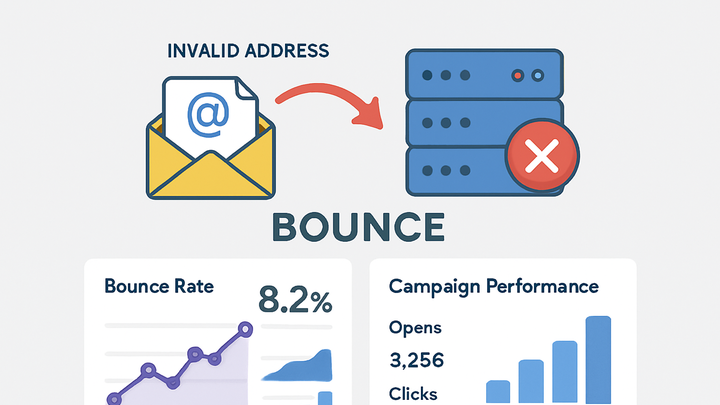Published on 2025-06-26T04:21:49Z
What is a Hard Bounce? Examples in Analytics
As part of email deliverability analytics, a Hard Bounce denotes a permanent failure in email delivery. Hard bounces occur when an email cannot be delivered to the recipient’s inbox due to permanent reasons, such as an invalid or non-existent email address, a blocked domain, or the recipient’s server rejecting the message outright. Tracking hard bounces is crucial for maintaining list hygiene, sender reputation, and accurate campaign performance metrics. By monitoring hard bounces, marketers and analysts can identify invalid addresses, cleanse mailing lists, and optimize deliverability. While web analytics tools like GA4 or privacy-focused platforms like PlainSignal do not directly capture email bounce data, they can integrate with email service providers (ESPs) or ingest bounce events via Measurement Protocol or custom event APIs to provide a unified view of user engagement across channels.
Hard bounce
A Hard Bounce is a permanent email delivery failure due to invalid addresses or blocked domains.
Why Hard Bounces Matter
Understanding hard bounces is essential for anyone running email campaigns or analyzing marketing performance. They directly affect your sender reputation, list quality, and the accuracy of your engagement metrics. High hard bounce rates can trigger spam filters, degrade deliverability to valid recipients, and skew analytics data, making it harder to measure the true effectiveness of your email strategy.
-
Deliverability impact
Each hard bounce signals a failed delivery attempt. Internet Service Providers (ISPs) monitor your bounce rate and may throttle or block your emails if the rate exceeds acceptable thresholds (typically under 2%).
-
List hygiene
Removing invalid addresses reduces costs (especially on pay-per-email platforms) and prevents further bounce-related issues. Clean lists ensure you focus on engaged subscribers.
-
Analytics accuracy
Bounced emails never reach recipients, so opens and clicks can’t occur. Tracking hard bounces separately prevents underestimating engagement metrics like open rate and click-through rate.
Common Causes of Hard Bounces
Hard bounces are permanent failures caused by reasons that cannot be resolved by retrying the delivery. Identifying these causes helps in structuring corrective actions.
-
Invalid or non-existent addresses
Typos in the email address or domains that no longer exist will always bounce. Regularly validating email syntax and domains can catch many of these before sending.
-
Blocked or blacklisted domains
Some domains actively block incoming mail or are blacklisted due to past abuse. This results in an immediate hard bounce from the recipient server.
-
Closed or inactive mailboxes
When users delete accounts or when organizations disband, mailboxes may be closed. Any email sent afterwards will bounce permanently.
-
Policy restrictions
Recipient servers may enforce strict policies (SPF, DKIM, DMARC alignment) and reject emails that fail authentication or policy checks, causing a hard bounce.
Tracking Hard Bounces in Analytics Platforms
While specialized Email Service Providers (ESPs) natively report hard bounces, you can consolidate these insights into your broader analytics ecosystem. Below are methods to import or track hard bounce events in popular analytics tools.
-
Integrating hard bounce data into GA4
Use the Measurement Protocol or the Data Import feature in GA4 to send bounce events and counts as custom events. This approach centralizes email deliverability metrics alongside web analytics.
-
Measurement protocol example
fetch('https://www.google-analytics.com/mp/collect?measurement_id=G-XXXXXXXX&api_secret=YOUR_SECRET', { method: 'POST', headers: {'Content-Type': 'application/json'}, body: JSON.stringify({ client_id: 'CLIENT_ID', events: [{ name: 'hard_bounce', params: {count: 25, campaign_id: 'spring_sale'} }] }) });
-
-
Sending bounce events to PlainSignal
Use PlainSignal’s custom event API to log hard bounce counts alongside user events for privacy-focused analysis.
-
Custom event tracking code
<link rel="preconnect" href="//eu.plainsignal.com/" crossorigin /> <script defer data-do="yourwebsitedomain.com" data-id="0GQV1xmtzQQ" data-api="//eu.plainsignal.com" src="//cdn.plainsignal.com/plainsignal-min.js"></script> <script> // After receiving bounce data from your ESP const hardBounceCount = 12; PlainSignal('event', { name: 'hard_bounce', properties: {count: hardBounceCount, campaign: 'spring_sale'} }); </script>
-
Best Practices to Reduce Hard Bounces
Proactively reducing hard bounces improves deliverability and enhances engagement metrics. Adopt the following strategies to maintain a clean list and strong sender reputation.
-
Use double opt-in
Require subscribers to confirm their email address via a follow-up email. This ensures valid and active addresses enter your list.
-
Regular list cleaning
Periodically remove addresses that consistently bounce or remain inactive. Employ automated email validation services to flag invalid entries.
-
Implement email validation tools
Utilize real-time validation APIs to verify email syntax, domain validity, and mailbox existence before adding new subscribers.
